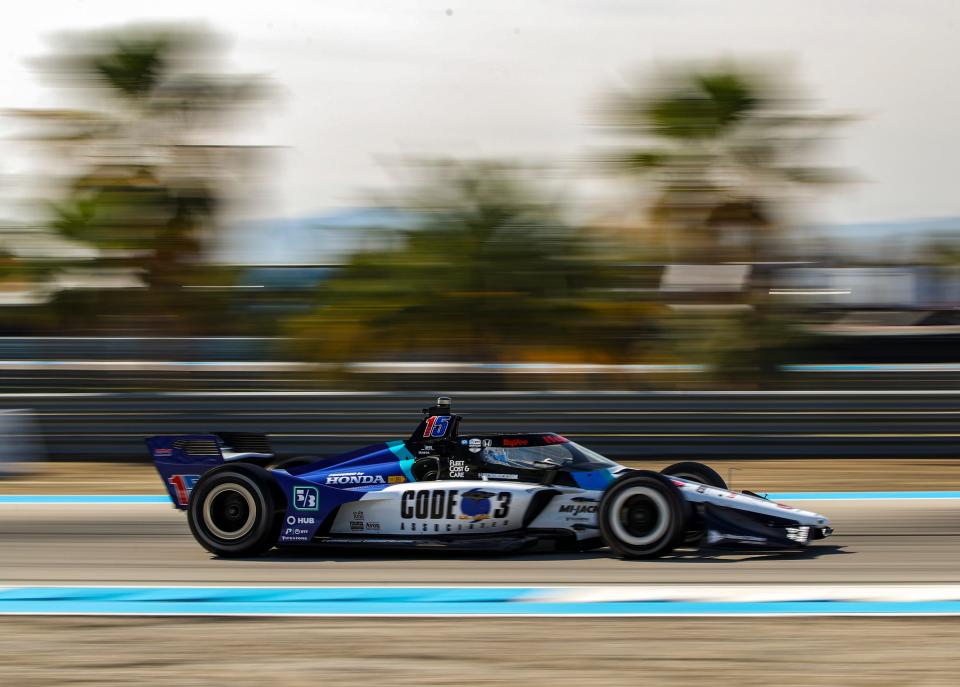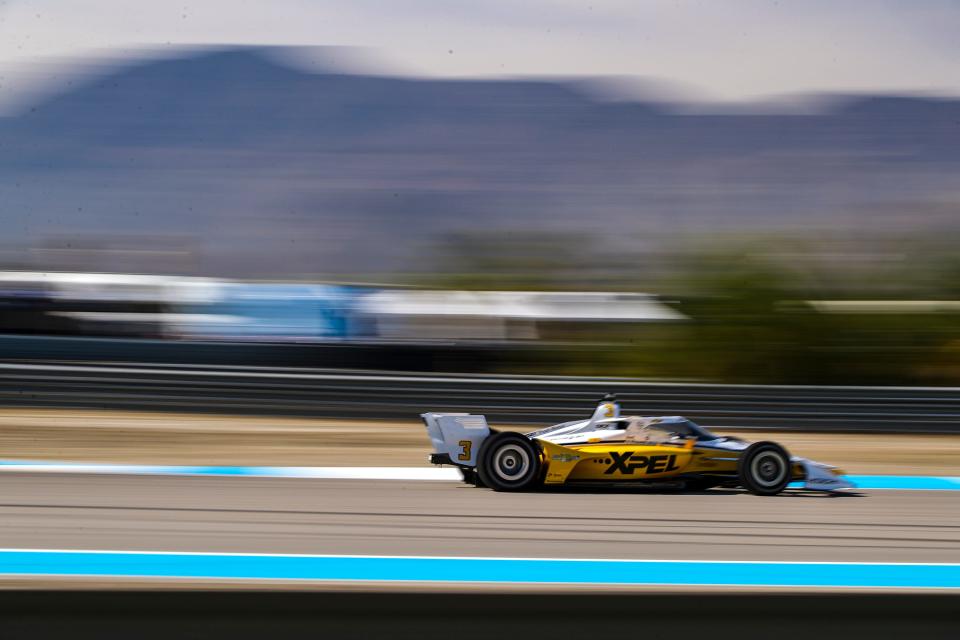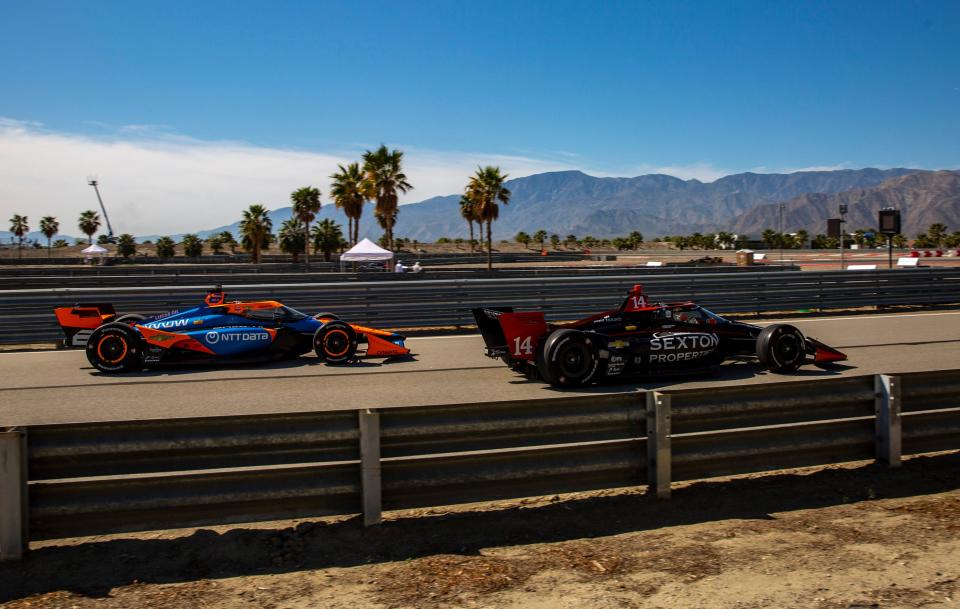Even without points, IndyCar drivers predict $1 Million Challenge battles to be 'chaotic'
THERMAL, Calif. – As speculation has swirled in the lead-up to IndyCar’s $1 Million Challenge about just how fierce drivers will fight with money on the line, rather than points – along with the risk of hefty repair bills for their bosses – Graham Rahal pointed back to the series’ early-pandemic pause.
While drivers were confined to their homes during IndyCar’s three-month pause, many invested hundreds – or thousands – of dollars into at-home simulators to allow them to play video-game versions of their day jobs. Quickly, series-wide races meant to be good-natured, entertaining exhibitions, turned into knock-down, drag-out, rivalry-inducing battles, while nothing but pride on the line.
So put $500,000 – even with maybe just $100,000 of it for themselves – on the line in Sunday’s 12-driver, 20-lap sprint race at The Thermal Club, airing on NBC for millions?
That’s just gravy.
“You could put us out there in a bunch of pedal carts, and everyone’s going to try and win,” Rahal told reporters Thursday.

In speaking with a half-dozen drivers late this week, now on the grounds of the private, gated community in the middle of the southern California desert, the sentiment was clear: There may be battles throughout Sunday morning’s pair of 10-lap heat races, as well as the ensuing 20-lap finale, where the risk-reward balance is off-kilter compared to a traditional race weekend.
But there will be times, too, where drivers might be typically content to sit and remain 7th and take the points home. Sunday, you might see Hail Mary moves the likes of which we hardly ever see across IndyCar’s regular season.
“I’m never a fan of making the team spend more money (on repairs) than they have to, so I won’t really change my approach too much,” Pato O’Ward said. “But I do think people will have less of an issue going elbow-to-elbow, because you know you don’t have a penalty to your future (in the championship).
“You’ll definitely see a lot more risks in the middle. In a normal IndyCar race, 7th vs. 6th doesn’t make much of a difference. Here (in the heat races), it’s big. You’re going to have guys go, ‘Uhh, let’s just see if this works out!’ And if it doesn’t, you weren’t going to (advance to the final) anyways, so might as well see. It'll get chaotic."
Answers to your questions: Here's how IndyCar's $1 Million Challenge works
Following Saturday’s four hours of testing on the 17-turn, 3.067-mile track, the field, split in half by a random draw at Thursday night’s Welcome Party, will run condensed versions of traditional road/street course qualifying sessions, where drivers have a set amount of time (in this case eight minutes) to turn their fastest lap possible. How they stack up will determined their starting position for a 10-lap heat race with that same group. The highest finishing six of those 13 (or in the case of Group 1, 14) drivers will together advance to the 20-lap finale.
With just 10 laps to make up as many as eight spots for someone to advance from their respective heat, it makes Saturday evening’s qualifying runs as high-pressure as ever. In a new quirk, IndyCar race control has also given drivers 40 seconds of push-to-pass boost to use up during their eight-minute qualifying session. The new wrinkle gives drivers and teams the decision of whether to gamble perhaps the future prospects of their entire weekend on a single lap – and burn it all at once – or save some, in case they need another lap, and hope several other drivers stumble, too.
That tension only feels increasingly heightened for those randomly selected for Group 1 – a 14-car collective that includes all three Team Penske drivers, a pair from Andretti Global, six-time champ Scott Dixon and inarguably the fastest drivers from Rahal Letterman Lanigan Racing (Christian Lundgaard), Meyer Shank Racing (Felix Rosenqvist), Juncos Hollinger Racing (Romain Grosjean), Ed Carpenter Racing (Rinus VeeKay) and AJ Foyt Racing (Santino Ferrucci).

“I think everyone is Group 1. That’s stacked. Group 1 is stacked,” said Scott McLaughlin on Friday afternoon, as he chatted with Alexander Rossi during the closing minutes of a midday press conference.
Replied Rossi with a pleased grin, who finds himself in Group 2 with his other two Arrow McLaren teammates: “Not a nice group.”
“I think at the end of the day, we’ll put on a show. That’s what it’s all about,” McLaughlin said minutes earlier. “It’s funny, when you dangle a carrot in front of a bunch of race drivers with a bunch of egos, we want to win – regardless of what event we’re in. Whether it’s for $1 million, $4 million, or 50 cents. We’ll just race for that win.”
And McLaughlin said he’s willing to bump anyone out of the way to get there.
“It could be (his seemingly estranged former ‘Bus Bro’) Josef, Alex, Rinus. I don’t give a (expletive).”
Insider: Why $1 Million Challenge winner might pocket just $100,000
As O’Ward hinted, some of the day’s most high-energy action may be found in the closing couple of laps of the pair of heat races, as drivers anywhere from 4th to 9th bang wheels, brake late and duel for the final few spots to position themselves to collect a chunk of a $500,000 grand-prize. Most drivers pointed towards the wide, sweeping hairpins of Turns 2-3, as well as Turn 6 as spots where those defending will have to make pivotal decisions on whether to hug the corner and force trailing cars to swing wide – leading the leading car later to put power down on exit – or leave the inside open and brace for a ‘bang.’
And the Turn 4-5 chicane in between, many said, is plenty easy to hit a curb wrong and drop a wheel, or miss the apexes and completely ruin the next several complexes. The north end of the venue, with several rolling, undulating turns in quick succession, will moreso be places to watch for a competitor to make a mistake before you pounce.
Starkly different from last year’s two-day Open Test, race control threw just a single red flag through five hours of on-track running Friday. The hope, though, is the heats, as well as the main event – which will be split into a pair of 10-lap segments with a 10-minute ‘halftime’ during which teams can refuel and tinker with minor changes – drivers will be constantly running full throttle without fuel saving in mind.
Some drivers, though, hypothesized that the finale’s first 10 laps could end up rather tame. Rossi revealed that a fuel stint while running all-out would be roughly 18 laps, meaning the back-half of the finale Sunday will see drivers fill their tanks back up while running tires that may be more than halfway past their ideal lifespans.
Theoretically, a driver starting 12th in the finale could drift back the pack and run as many as 10 seconds per lap off the pace, and just make certain they don’t get lapped. The ensuing halftime would allow them to pull even with the field and give them a roll of the dice to try and pass 11 cars in 10 laps to multiply their team’s earnings by more than 40.
It’s the type of wacky strategy no driver or team would’ve ever dared to dream of at St. Pete, and you won’t see it next month at Long Beach or anywhere else on the calendar. But it’s just what this type of out-of-the-box exhibition that has become increasingly popular in the mainstream sports world can deliver.
A lot on the line: Why IndyCar needs success with $1 Million Challenge

“The prize we’re advertising is awesome, but you’re going to have the same performance even if it’s all for nothing,” Rossi said. “It’s the same thing every time we hit the track: you’re going to try and be the best and beat everyone else.”
And, as Grosjean explained, this sprint format, without the allowance for pitstops for anything other than emergency service, and without fuel strategy coming into play, should increasingly put driver talent, experience and smarts at the forefront of it all. In a series that so often features an array of drivers in the Fast Six at each road and street course race, before one of IndyCar’s ‘Big Four teams’ all too likely wins, pure, raw speed and one’s ability to master the risk-reward sentiment of the weekend’s phases mean more than ever.
Perhaps, as Grosjean hopes, it could lead to a surprise winner.
“Teams like Penske and Ganassi are so impressive in what they do in the pits,” he said. “And at St. Pete, Palou and Dixon finished 6th and 9th, and I don’t think they passed a car on-track.
“Just ‘pure racing’ is going to be so important. And I don’t care if it’s points or money or anything in the end. I do it because I love racing.”
This article originally appeared on Indianapolis Star: IndyCar drivers predict $1 Million Challenge will be 'chaotic'

